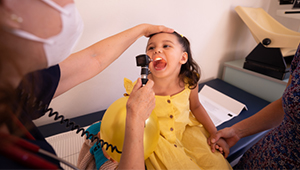Some adolescents are more likely to use patient portal than others

A new study aims to understand trends in digital care communication among teens
Increasingly, health care and communication between patients and care teams takes place digitally. More health care systems are offering adolescents the option to set up and manage patient portal accounts, where they can talk with their health care team, schedule appointments, and access their medical records. Researchers at Kaiser Permanente Washington Health Research Institute (KPWHRI) are working to understand the needs of adolescents when it comes to digital tools such as secure messaging, in order to better address possible barriers to use or access.
New results from their study published in Pediatrics provide insight into which adolescent populations are more likely and less likely to use an online patient portal to communicate with their health team using secure messaging. The study found that teens who had recently had a primary care visit, had private insurance, or identified as female, transgender, or gender expansive were more likely to use the portal. Those who had public insurance or identified as Asian, Black, Pacific Islander/Native Hawaiian, or Hispanic/Latino, or reported no race or ethnicity, were less likely to use the portal.
“This is the first study of its kind that we are aware of in adolescents,” said lead author Annie Hoopes, MD, MPH, an acting assistant investigator at KPWHRI and physician with Kaiser Permanente Washington. “So, these findings are an early signal that there are potentially some barriers to use of the online portal in this population, and that there are also some things that facilitate portal use, such as a recent visit with a primary care doctor. This is really helpful information to inform further work to match the online tools with what patients need.”
Data from a large population
The researchers used health record data from Kaiser Permanente Washington for a several-year period, beginning in January 2019, when adolescent members ages 13 to 17 were first able to manage their own online patient portal accounts. They tracked monthly counts of secure messages, looking at almost 40,000 unique teens and over 600,000 monthly observations from the beginning of the study through December 2021. They looked only at whether or not messages were sent from a teen account in a given month, not the number of messages or the content of messages.
“One big challenge that we faced was that a very small percentage of eligible teens were using the portal when we began the study,” Hoopes said. “Over time, that percentage crept up, so over the full time period we were able to look at quite a large population.”
The study also encompassed nearly 2 years of the COVID-19 pandemic, when many health care visits that had previously taken place in person moved to a digital format.
As the researchers had hypothesized, there were differences between teens who were more likely to use the portal and those who were less likely to use it. While the study did not analyze the reasons behind the use patterns, the authors wrote that some teens may be more motivated to have direct conversations with their care team because they are receiving more health care services or because they have been encouraged by their doctor to use the online tools to get in touch. Low use could be motivated by a lack of experience navigating the health care system or potential concerns about confidentiality.
The authors emphasized that while the data is helpful to inform further research, it shouldn’t be used to generalize or label different populations.
“The way sex, gender identity, race, and ethnicity are tracked in the health record don’t always match perfectly with how someone identifies, and the record only reflects what someone feels comfortable sharing,” Hoopes pointed out. “We also didn’t look at the content of the messages, so we don’t have insight into why patients were reaching out. Ultimately, it’s likely that some or all of the patterns we saw, particularly for people who aren’t using the portal, are related to structural barriers.”
The findings that teens of historically marginalized racial or ethnic identities were less likely to use the portal are consistent with prior studies in adult populations, she said, indicating that further equity-informed research is an essential step to design interventions that can remove barriers disproportionately faced by these communities. The researchers controlled for other variables, such as insurance status and use of preventive care services, which are known to contribute to disparities.
“In order to ensure that we’re providing equitable, effective care to teens,” Hoopes said, “we have to make sure we’re meeting everyone’s needs.”
Next steps
The researchers plan to follow up on this work with a qualitative research study involving teens, parents/guardians of teens, and primary care clinicians who provide care to teens to better understand how care journeys might be facilitated by the teen patient portal. Ultimately, they hope to design and test interventions that leverage the patient portal to improve access to care and reduce negative health outcomes among teens.
KPWHRI coauthors on the study are Yates Coley, PhD; Sharon Fuller, BA; James Ralston, MD, MPH; and Rita Mangione-Smith, MD, MPH.
The study was supported by grant number K12HS026369 from the Agency for Healthcare Research and Quality.
By Amelia Apfel
New findings

Patient-centered perspectives on teen mental health
Annie Hoopes, MD, MPH, shares insights from an ACT Center study on integrating adolescent mental health in primary care.
Pediatric research

Improving child health and care with quality measures
KPWHRI Executive Director Rita Mangione-Smith, MD, MPH, talks about her research to advance pediatric care
VOICE STUDY

Understanding young adults’ experiences with cancer
The VOICE study aims to improve the health and health care of people who had cancer as adolescents and young adults.



